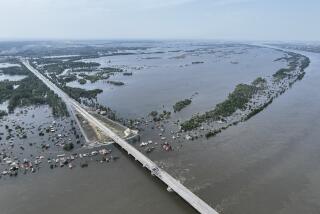THINKING BIG : Failures : When Dreams Turn to Delusion : A railroad to nowhere, dried-up lakes and eroded land are monuments to Soviet-era megalomania.
- Share via
MOSCOW — From the Baikal-Amur railroad that runs 3,000 miles through economically untapped wilderness, to the unnavigable White Sea Canal that cost as many as 100,000 lives in construction, the “hero projects” of the former Soviet Union stand as monuments to megalomania.
The Russian landscape is blighted with failed feats of outsize engineering, most of which have ruined the environment, bankrupted the government and crushed individuality with their intimidating presence.
And while the Communist ideology that gave rise to the mega-projects has collapsed, Russia’s tradition of architectural gigantism is tenacious.
The current leadership, for instance, has embarked on reconstruction of the Cathedral of Christ the Savior, which was the Orthodox world’s largest church before dictator Josef Stalin had it dynamited in 1931. Work continues on huge irrigation projects that, reversing intentions, have parched rivers and salinized farmland.
That Russian rulers have long sought to express power with imposing construction is in keeping with worldwide imperial custom, writer Alexander A. Kabakov says.
“It is typical of the totalitarian mentality to behave aggressively against man and nature,” says Kabakov, who has written on Russia’s failed hero projects. “There is no better way to make an individual feel like a nonentity than to stand him against some gigantic monument that makes him feel as insignificant as a grain of sand.”
While manifestations of empire can be seen from the ancient pyramids to the palace at Versailles to Mt. Rushmore, analysts here say Russia’s attempts at architectural domination often ended in disaster because they were designed to symbolize the erroneous premise that Soviet power ensured a superior way of life.
Alexei V. Yablokov, chairman of Russia’s Commission on Ecological Security, blames decades of brainwashing for the prevalence of superlatives in Russian construction and the havoc they have wreaked with the environment.
“For many years in this country, we were taught not to wait for gifts from nature, rather that it was our duty to take them,” says Yablokov.
Most often cited as first among equals in the field of disastrous projects is the Baikal-Amur Railroad, or BAM.
Stalin mobilized half a million prisoners to carve out a route across five mountain ranges, 17 rivers, pristine timberland, permafrost and swamps. The late Soviet leader Leonid I. Brezhnev revived the project with volunteers, and the final push under President Mikhail S. Gorbachev finished the feat in 1989.
But BAM was and is a path to nowhere. Its designers envisioned construction of industries along the rail lines to exploit Siberia’s natural resources, but post-Soviet Russia has no funds for the follow-through.
Russia’s huge hydroelectric power projects, from the Bratsk station carved out of Siberian wilderness to the Rybinsk dam holding back the largest man-made reservoir in the world, caused incalculable environmental damage but provided electricity for millions.
The quest for agricultural greatness, however, inspired the most disastrous projects, like the diversion of rivers to irrigate the cotton fields of Central Asia. The Aral Sea has lost one-third of its volume since 1960.
Likewise, the Virgin Lands project of the 1950s eroded the delicate steppes of Kazakhstan, destroying half of their 250 million acres with unsuitable grain crops in a misguided drive to expand the Soviet breadbasket.
One Stalin brainstorm of the 1930s was so excessive it overwhelmed the planners.
The Palace of Soviets was to have stood on the site of the razed Cathedral of Christ the Savior in Moscow, reaching 1,300 feet into the sky and crowned with a likeness of Soviet founder V. I. Lenin, which alone would have dwarfed the Statue of Liberty.
But design work and excavation took a decade, and then World War II intruded. The first metal forms sunk for the foundation were salvaged for use as antitank barriers. By the time peace came, Stalin had lost interest in the “project of the century.”
The huge pit dug for the complex was converted to a public swimming pool, but it was closed and drained last year in preparation for, yes, reconstruction of the world’s largest Orthodox cathedral.
More to Read
Sign up for Essential California
The most important California stories and recommendations in your inbox every morning.
You may occasionally receive promotional content from the Los Angeles Times.














